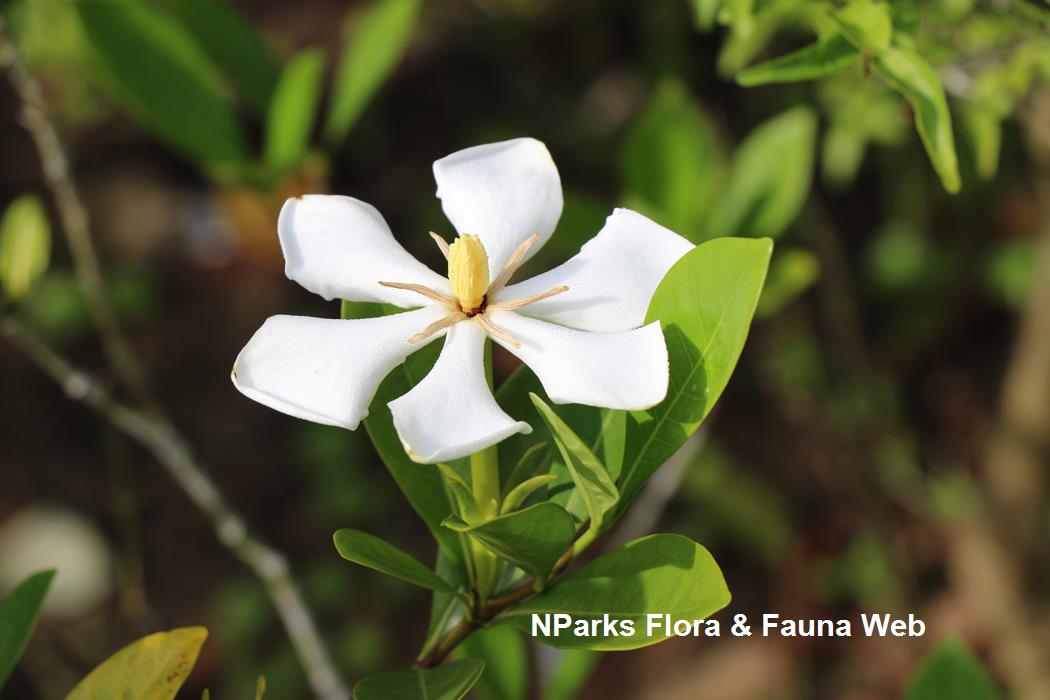
Name
Classifications and Characteristics
| Plant Division | Angiosperms (Flowering Seed Plants) (Dicotyledon) |
|---|---|
| Plant Growth Form | Shrub, Tree (Shrubby (1m-5m)) |
| Lifespan (in Singapore) | Perennial |
| Mode of Nutrition | Autotrophic |
| Maximum Height | 1.5 m |
| Maximum Plant Spread / Crown Width | 1.5 m |
Biogeography
| Native Distribution | Australia |
|---|---|
| Native Habitat | Terrestrial |
| Preferred Climate Zone | Tropical, Sub-Tropical / Monsoonal |
| Local Conservation Status | Non-native |
Description and Ethnobotany
| Growth Form | Large, woody, evergreen shrub or small tree with rounded crown. |
|---|---|
| Foliage | Glossy, dark green leaves are elliptic with entire leaf margin. Leaves are deeply veined with prominent lateral veins, creating an uneven leaf texture. |
| Stems | Woody stem has smooth, greyish bark. |
| Flowers | White, star-shaped flowers have 6 - 7 oval, slightly overlapping petals. Flowers have a strong, sweet fragrance and are produced throughout the year. They are pollinated by moths. |
| Cultivation | This species blooms best in full sun, but also tolerates partial shade. Although tolerant of many soil types, it grows best in deep, acidic soils that are well-draining but moist. Mulch the plants with compost to prevent the soil from drying out or the roots from overheating. Feed plants with a palm fertilizer 3 times a year and prune after flowering. |
| Etymology | The genus Gardenia is named after Dr. Alexander Garden (1730 - 1791) , an American doctor who also studied plants and animals. Species scabrella means somewhat scabrid. |
Landscaping Features
| Landscaping | This species is grown for its large, fragrant flowers. In the city of Cairns, Australia, this species is a common roadside shrub. It is suitable for container plantings and makes an attractive specimen plant. Avoid planting several types or too many fragrant flowering shrubs together, because the aromas could clash or become too strong. |
|---|---|
| Desirable Plant Features | Fragrant (Flowers) (Day), Ornamental Flowers |
| Landscape Uses | Container Planting, Parks & Gardens, Small Gardens |
| Thematic Landscaping | Fragrant / Aromatherapy Garden |
Fauna, Pollination and Dispersal
| Fauna Pollination Dispersal Associated Fauna | Butterfly-Attracting |
|---|---|
| Pollination Method(s) | Biotic (Fauna) |
Plant Care and Propagation
| Light Preference | Full Sun |
|---|---|
| Water Preference | Lots of Water |
| Plant Growth Rate | Moderate |
| Rootzone Tolerance | Moist Soils, Well-Drained Soils |
Foliar
| Foliage Retention | Evergreen |
|---|---|
| Mature Foliage Colour(s) | Green |
| Mature Foliage Texture(s) | Glossy / Shiny, Raised / Sunken Veins |
| Prominent Young Flush Colour(s) | Green |
| Young Flush Texture(s) | Glossy / Shiny |
| Foliar Type | Simple / Unifoliate |
| Foliar Arrangement Along Stem | Opposite |
| Foliar Attachment to Stem | Petiolate |
| Foliar Shape(s) | Non-Palm Foliage (Elliptical) |
| Foliar Venation | Pinnate / Net |
| Foliar Margin | Entire |
| Foliar Apex - Tip | Acute |
| Foliar Base | Acute |
| Leaf Area Index (LAI) for Green Plot Ratio | 4.5 (Shrub & Groundcover - Dicot) |
Floral (Angiosperm)
| Flower & Plant Sexuality | Bisexual Flowers |
| Flower Colour(s) | White |
|---|---|
| Flower Texture(s) | Smooth |
| Flower Grouping | Solitary |
| Flower Location | Terminal |
| Flower Symmetry | Radial |
| Individual Flower Shape | Stellate / Star-shaped |
| Flowering Period | Free-Flowering |
| Flower Lifespan on Plant | Several Days |
Image Repository
Others
| Master ID | 733 |
|---|---|
| Species ID | 2028 |
| Flora Disclaimer | The information in this website has been compiled from reliable sources, such as reference works on medicinal plants. It is not a substitute for medical advice or treatment and NParks does not purport to provide any medical advice. Readers should always consult his/her physician before using or consuming a plant for medicinal purposes. |






